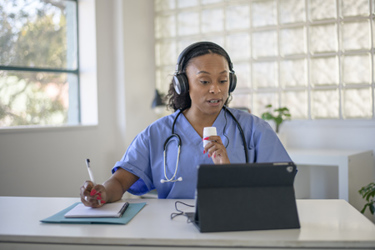Key Learnings To Optimize Clinical Trials During COVID-19
By Sabrina Martucci Johnson, president & CEO, Daré Bioscience

Designing the optimal clinical trial is both an art and a science. When the art and science are perfectly balanced, studies meet all regulatory authority requirements and include additional assessments that clearly demonstrate what distinguishes the clinical candidate as the best therapy for the target population. The most effective trials go beyond addressing only the symptoms of a given disease or condition and any adverse events of the therapy; they demonstrate how the therapy otherwise meets patients’ needs and impacts their quality of life. Optimizing study design is all in the details, from enrolling the most appropriate patients to determining which data are key to assessing the impact of the clinical candidate and then optimizing how to capture those data to collecting all those relevant data for inclusion in future new drug application (NDA) submissions. Even with the most careful planning, trials are impacted by variables beyond control. Nimble, flexible teams are key, as are strong contingency plans.
COVID-19 Complicates Clinical Trial Operations
Despite the best planning possible, the COVID-19 pandemic presented one of the biggest challenges the biopharma industry has faced to date. The global nature of the pandemic that led to worldwide lockdowns and the unknown facts about transmission, treatment, and prevention in the early months raised numerous obstacles for conducting clinical trials, bringing many to a grinding halt. Sponsors and clinical partners found that they had limited access to trial sites, needed to reduce the frequency of in-person site visits, and needed to build out a toolkit of virtual communication options. All of these things were necessary to keep patients and clinicians safe while keeping the clinical trials on track to gather all required data for the study.
In early 2020 when the pandemic hit the U.S., Daré Bioscience preapred to initiate a Phase 3 multicenter study for bacterial vaginosis (BV), the most common vaginal condition affecting women of reproductive age. Designing a clinical trial that would allow us to successfully conduct this study despite the many unknowns we faced at the time required new thinking, lots of flexibility, and a constant focus on the needs of the study participants, clinicians, trial sites, and the challenges we were facing in a virtual environment. Our team needed to identify, anticipate, and address these challenges and develop tools and contingency plans to ensure the study could continue and accomplish its goals. The biggest challenges among these were meeting FDA regulatory requirements while also ensuring that trial participants could complete the study with a limited number of in-person visits and optimizing data collection to capture all required information in a highly reliable and timely manner. We recognized early on that we needed a new, innovative approach that would rely on streamlined and centralized processes, virtual visits, and an efficient strategy and tool set to capture data.
Switching To A Central Lab To Meet FDA Requirements
As with any clinical trial, meeting FDA requirements was essential for success with our study. In this newly virtual setting, we had to identify strategies for navigating the decrease of in-person visits to collect all the data necessary to meet FDA guidelines. For our study, the FDA had an unprecedented requirement: confirm the presence of BV using a microbiology lab-based assessment. Prior to the pandemic, each trial site would be trained individually on how to conduct the assessment. However, in the midst of COVID, this wasn’t possible. This was the first challenge our team faced, and we quickly determined that it was most efficient to centralize the confirmation of BV by having all samples shipped to a central lab for analysis. Additionally, in the trial design of past studies, participants were required to return to the trial site within a week of the initial screening process, once test results were available, to determine if they qualified for the study, which was not feasible during COVID. To limit the number of clinic visits and to maximize the number of participants in the study, we screened and enrolled all women who presented with BV upon their first visit, assuming the risk that some trial participants may not qualify for the analysis at the end of the study.
Minimizing Site Visits, Maintaining Patient Engagement
Just as important as meeting the FDA requirements, we needed to ensure safe and easy access for all study participants. Since our study began during the height of the first wave of COVID-19 infections in the U.S., it was critical to minimize clinic visits for multiple reasons: unknown access to trial sites due to possible closures, fear of the pandemic, stay-at-home orders, and altered clinic procedures. Minimal site visits also allowed Daré a likelihood of maintaining strong trial enrollment.
The selected patient recruitment vendor allowed patients to prescreen for the trial by using a virtual screening process, which included an internet-based screener, followed by a phone call, and finally a video call. We chose this methodology so that by the time the participant arrived at the clinic, they knew they were qualified to participate in the study, eliminating extra and unnecessary trips to the clinic. Additionally, trial sites were informed that if potential participants arrived and were presenting with BV symptoms, they would be asked to participate in the trial and could be enrolled that day. This meant they would only have to return for two checkup visits (as opposed to up to four) as part of the trial.
Optimizing Data Collection
Finally, to streamline data capture, participants provided their outcomes directly through telehealth appointments and a patient diary portal, which was accessible on any internet enabled device, rather than in the clinic. The patient diary portal allowed for real-time data capture without requiring that participants come back to the office. To make the diary portal easily accessible with minimal disruption, the participants were allowed to download the e-diary application on their smartphone, so that they didn’t have to worry about a second device or have the inconvenience of bringing it back to the office. The one questionnaire at the end of the study that was not included on the patient diary portal could be completed via a telehealth visit, so that the participant again did not need to come to the office. With patient-reported outcomes becoming increasingly popular and accepted in the clinical trial space, this data collection method proved ideal for patient convenience and safety during COVID and was relied on heavily throughout the entirety of this trial.
Putting It All Together — Without Compromising Outcomes
Designing and conducting trials during a global pandemic forces clinical teams to be creative, to explore the use of technology, and to design a trial that meets the participants where they are — without compromising outcomes. In fact, these learnings yielded newfound efficiencies related to gathering timely, reliable, and compelling product data that can endure the pandemic and beyond. And the tools we used — centralized lab testing, patient reported data, and electronic patient portals — are just some of the many ways to overcome the pandemic’s challenges and provide long-term methods for minimizing burdens on patients and trial sites, while still capturing the data required by the FDA for a successful trial.
 About The Author:
About The Author:
Sabrina Martucci Johnson founded Daré Bioscience, Inc. in 2015 and has served as president, CEO, and a board member since its inception. She previously held multiple leadership roles at WomanCare Global Trading and Cypress Bioscience, and began her career as a research scientist with Baxter Healthcare.
